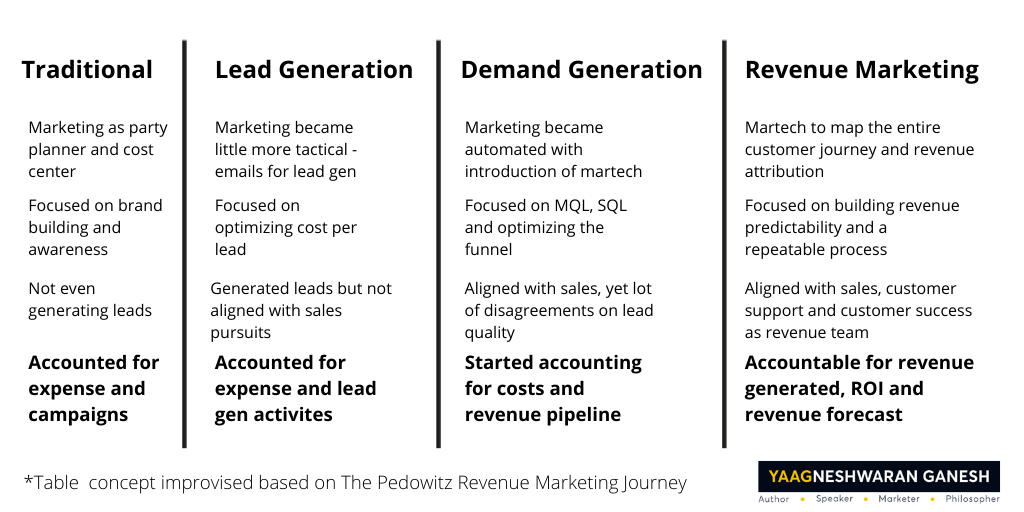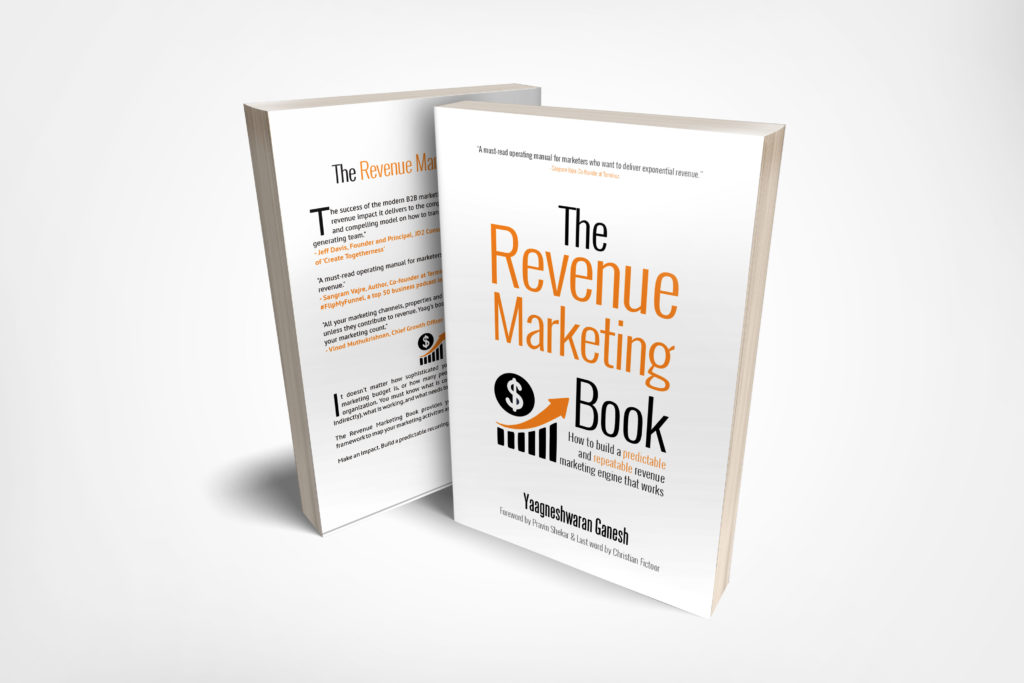Soon after I published my previous blog on setting up the revenue marketing engine, a lot of people reached out to me asking me to share about – how one can transition from their traditional way of measuring marketing and get into a proper revenue marketing journey.
Given the COVID19 situation around the globe, the lockdowns and slowing down of business everywhere — it is more important than ever before to transform the way you look at marketing, the way you map your marketing activities to revenue and more.
People asked – are there any marketing frameworks for getting your revenue marketing right?
So, I thought it’s a good idea to write about transitioning from traditional marketing frameworks across the revenue marketing maturity stages. And more importantly wanted to share a revenue marketing framework I came up with called the GAME model.
However, it makes more sense to start with understanding the revenue marketing maturity models before getting into the framework.
Transitioning from Traditional Marketing Frameworks to the Revenue Marketing Approach:
The COVID scenario has made sure that all the conferences and tradeshows around the globe are canceled (not even postponed). If your company depends on trade shows and events for customer acquisition, then that option is gone out of the window for quite some time in the future.
You need to adapt. It needs to happen now. More importantly, your revenue marketing maturity will determine your sustainability. (unless you can map your marketing effort to a revenue outcome, your role is going to become irrelevant)
Everyone in the C-suite wants to see the proof of marketing making a real impact on revenue. For instance, the CEO wants to know how marketing can contribute to increasing the market share, the COO wants to know how marketing can contribute to increasing the operational efficiency in marketing and sales, and so on.
So, as marketing is adopting the new norms of increased accountability, one of the biggest challenges you might come across is resistance to change.
The resistance isn’t just because of the additional accountability, but mainly because the organization cannot afford a dip in profitability or revenue as the metamorphosis happens. The change can be expansive – could range from an org-change of who reports to whom, to the change in KPIs measured for each role, to change in the way collaborations happen and more.
This is the stage where you might also go through a lot of changes in your martech stack, change the way you look at data – get rid of a few tools that aren’t helping you measure key data points, whereas add some new tools to your stack to make sure you capture the complete customer journey as much as possible so that you can measure revenue impact.
It is going to be like colonoscopy — not very pleasant while it happens. But once you go through it — you know you did the right thing.
To help you understand where you stand in terms of revenue marketing maturity and the stages of transitioning, I’ve put together a table representing the four different stages. Each stage represents the outlook of marketing by the companies in those respective stages, their focus areas and what they are accountable for.


Stage 1:
The companies in this stage are not necessarily startups or early stage companies. There are several companies that have been in existence for more than two decades and still cannot map marketing efforts to revenue. Companies in this stage often tend to have marketing teams that act as a service provider to sales teams.
They typically create content or run campaigns in a reactive manner based on the request they get from sales teams. They don’t have established processes and tend to have very minimal use of martech. The primary role of marketing teams in this stage of maturity is to create awareness and run ads.
KPIs measured in stage 1: Cost incurred, number of marketing activities.
Stage 2:
A significant majority of companies fall in this category. The companies in this stage have a good amount of awareness on who their target audience is, product use-cases for each customer persona and so on.
In fact, there is some level of martech adoption too. For instance, the companies in this category will have invested on a CRM. But the CRMs are primarily for marketing teams to upload the prospect database and run email campaigns. The key issue in these companies is that the sales teams rarely update the CRMs.
KPIs measured in stage 2: Number of leads delivered to the sales team.
Stage 3:
This is the stage where most organizations identify themselves with. The companies in this stage have their marketing plans aligned with business goals but not specific revenue goals. They go beyond marketing qualified leads (MQLs) and know the potential revenue from the pipeline generated. The martech adoption and automation across different stages of the funnel are well in place. But the company hasn’t identified the contribution of each marketing channel to the revenue generated.
KPIs measured in stage 3: Cost per lead, potential pipeline generated.
Stage 4:
There are very few organizations who are in this stage of revenue marketing maturity. The compensation of marketers in these organizations are tied to revenue goals and is based on performance. The marketing plans in these companies clearly align with specific revenue goals, and precisely know the revenue contribution expected from each marketing channel. These companies typically have great martech adoption across the stages of customer journey and enable sophisticated levels of data collection such as prospect intent and fit data (not just in terms of third-party sources such as social media and press releases, but also direct zero party data collection)
KPIs measured in stage 4: Contribution to revenue, ROI and customer lifetime value.
The GAME Model
If you notice across all the four stages, the KPIs measured are so very different. And as long as teams work in silos, we continue to have gaps. Here are a few examples of gaps you might come across in organizations where marketing and sales teams tend to work in silos:
- Marketers stick to good old methods of what worked for them in the past and don’t experiment enough to stay relevant in the ever-changing business scenarios.
- Sales and marketing not being aligned. For instance, the sales teams don’t communicate the essence of customer conversations with the marketing teams (which could be of great value in creating relevant messaging or even tweaking the product positioning).
To avoid silos and contribute to revenue in a synchronized manner, here’s a revenue marketing framework I came up with. I call it “The GAME Model”.
It stands for Gather —> Agree —> Map —> Execute.
The idea of the GAME model originated while mentoring a software startup in the Netherlands in January 2019. We were in the process of identifying why the revenue per customer was so low despite the efforts from their marketing and sales teams.
In the process, we identified a few key factors that contributed to deal size and closure. Finally, we arrived at a four-step process where marketing and sales teams could work as one unit to help the customer achieve their goals and thereby directly contribute to the organization’s revenue.
1. Gather:
- Invest your time and energies to identify the accounts you want to spend your marketing dollars and efforts on. It is not necessary that the accounts you want to go after should be net new accounts.
- As marketers, we shouldn’t miss out on marketing to existing customers, where we can ‘land and expand’ the opportunities within an account.
- Identify the marketing sources that contribute to revenue such as content, PPC, events, etc. and the areas of collaboration with the sales team such as delivering the right case studies, competitor comparison sheets, ROI calculators, solution briefs, analyst relations and so on.
2. Agree:
- Work as one team along with your sales group and finalize the accounts that have revenue potential and can be accelerated through the sales funnel stages. Make sure the KRAs of the marketing and sales team align towards the same goals.
- Classify your accounts into hot, warm, and cold buckets based on a combination of factors such as engagement, lead scores shared by sales, look-alike companies (companies like existing customers in terms of industry, domain, size, revenue, etc.) and more.
- Go back and forth on account-level feedback from the sales team and classify the contacts in each account into the following categories: users, influencers, and decision-makers. Agree upon the right messaging and narrative for each account.
3. Map:
- Map the pain points identified for each account to your resources and products/solutions. Map the content marketing efforts to different stages of the funnel and build a list of customized content resources/assets addressing those problems.
- Estimate the potential revenue for each target account and get an expected total contract value over a specific time period. For example, the potential revenue from an account could be $3 million but across 4 years. Mapping contract value over time periods will help you get a revenue value for the current year.
4. Execute:
- Execute your account-based marketing (ABM) campaigns –- right messaging/story supported by relevant resources and solutions targeted and personalized specifically for each persona within each account.
- Run go-to-marketing (GTM) campaigns across identified marketing channels and track the pipeline velocity for the targeted accounts.
- Keep pivoting and tweaking your approach until your marketing and sales efforts are completely optimized for revenue.
To sum up, the key is to set up your marketing operations in such a way that every team and every team member contributes to revenue and that it is measurable and attributable. If you can manage that, and continuously keep improving every moving part, you end up setting the revenue marketing flywheel in motion – from strategy to execution to revenue.
Download “The Revenue Marketing Book”





very good concept. If this is done by lead generating companies will help a lot
Thank you Sachin, for your kind words. I’m glad you think so 🙂
[…] In fact, last year, while working on a client project in the Netherlands, I came with a revenue marketing framework called “The GAME Model”. (Read here to know more about “The GAME Model”) […]
[…] January 2019, while mentoring a software startup in the Netherlands, I came up with the GAME Model for revenue marketing, which I’ve covered in ‘The Revenue Marketing Book.’ While I don’t […]
[…] stage of the GAME model are you in? Are your marketing and sales teams in sync with respect to the accounts they are […]
[…] You can read more about the GAME model on Yaag’s blog. […]
[…] On one side, marketers tend to stick to good-old methods of what worked for them in the past and don’t experiment enough to stay relevant in the ever-changing business scenarios. On the other side, sales and marketing not being aligned is an age-old problem. Iron the situation out by sticking to The GAME Model of Revenue Marketing. […]
[…] by Yaag Ganesh, author and marketer who helps early stage startups build up their businesses, the GAME model is a simpler framework that ultimately requires the same kind of work, broken down into four […]